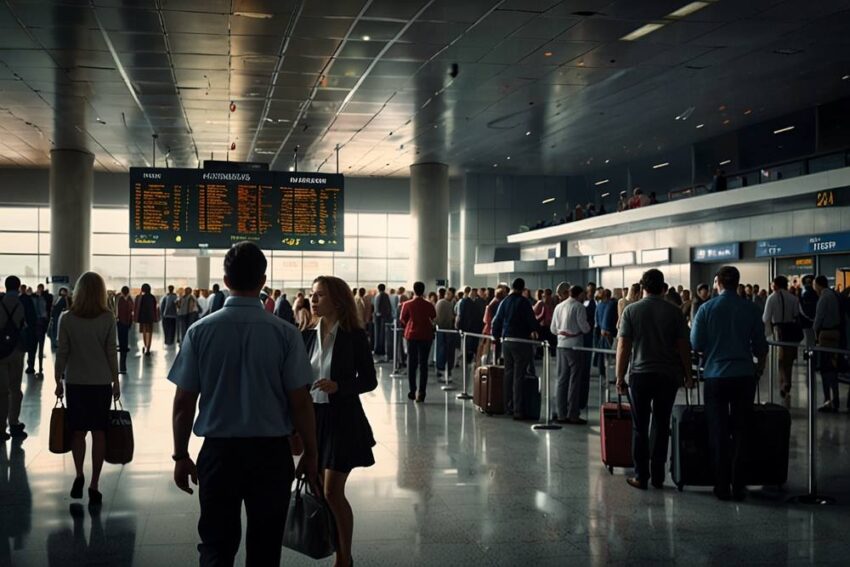Published on
November 7, 2025

The US government shutdown has plunged air travel into chaos, with major airports across the nation facing massive delays and cancellations. Among the hardest hit are Anchorage International Airport, Alaska, Charlotte Douglas, Dallas Love Field, Daniel K. Inouye, Honolulu, and Indianapolis. These airports have joined forces to tackle the growing crisis, as flight operations struggle to keep up with staff shortages and operational disruptions. The shutdown has forced the FAA to implement air traffic reductions, causing widespread flight delays and cancellations. Passengers flying through these airports should be prepared for significant disruptions in their travel plans.
Anchorage International and other affected airports are working to manage the overwhelming demand and ensure safety, but travellers must remain vigilant and flexible during this difficult time. This is the latest you need to know about how the US government shutdown is affecting your journey.
What Is the US Government Shutdown and How Does It Affect Airports?
A government shutdown happens when Congress and the President cannot agree on the federal budget. During this time, many government services stop, and government employees may not get paid. One of the biggest impacts is felt in airports, where staffing shortages lead to longer waits and flight disruptions.
The Federal Aviation Administration (FAA), responsible for air traffic control, is experiencing staff shortages due to the shutdown. Air traffic controllers and other airport staff are either working without pay or being stretched thin due to the reduced workforce. This causes delays and makes the entire air travel system more chaotic.
FAA Announces Reduced Air Traffic at Major Airports
To deal with this crisis, the FAA has decided to reduce air traffic by 10% at 40 major airports across the US. The reason for this is to ensure safety while managing the reduced number of air traffic controllers. Even though the risk of a major safety incident is low, the reduction in traffic will make air travel slower and less predictable.
The 10% reduction will affect airports that handle the most flights. These cuts will help relieve pressure on the overstretched air traffic controllers, giving them time to manage the remaining air traffic safely. But the reduction in flights also means longer wait times and more cancellations.
Which Airports Are Affected by the FAA’s Decision?
While the FAA has not published a full list of the 40 airports, some major airports have been named in the media. Airports like New York, Chicago, Atlanta, and Dallas are on the list, but the situation is still developing, and more airports may be added over time.
The five airports we are focusing on — Anchorage International (ANC), Charlotte Douglas (CLT), Dallas Love Field (DAL), Daniel K. Inouye International (HNL), and Indianapolis International (IND) — are likely to be affected, even though some have not been officially listed yet.
Anchorage International Airport (ANC), Alaska: A Remote Hub in Crisis
Anchorage International Airport (ANC) in Alaska is one of the airports that is explicitly named in the reduced air traffic list. Anchorage is a vital hub, especially for travellers going to remote parts of Alaska. Any reduction in air traffic here will be felt strongly by those who depend on flights to and from the region.
Even a 10% reduction can have a significant impact in Alaska, where there are fewer flights to begin with. This means fewer options for passengers and potential disruptions to cargo flights that serve the Alaskan community. Given Anchorage’s importance for travel within the state, the reductions may lead to even more delays and cancellations.
Charlotte Douglas International Airport (CLT), North Carolina: Major Hub Likely Affected
Charlotte Douglas International Airport (CLT) in North Carolina is one of the busiest airports in the United States. It handles a massive volume of passengers and is a key hub for domestic flights, especially for one of the largest US airlines. Although it has not been explicitly listed by the FAA, CLT is a major player in the US air travel network, and it is likely to be affected by the air traffic cuts.
The 10% reduction could lead to longer wait times for passengers flying in and out of Charlotte. With its high volume of flights, even a small reduction could cause significant ripple effects, including more cancellations and delays. Travellers flying from CLT should be prepared for potential disruptions and should monitor their flight status closely.
Dallas Love Field (DAL), Texas: Likely to Be Hit by Delays and Cancellations
Dallas Love Field (DAL) is another major airport that is likely to experience the effects of the 10% reduction in air traffic. The FAA has already indicated that Dallas/Fort Worth is on the list of airports that will be impacted, which means Dallas Love Field, a key airport in the Dallas metro area, will also be affected.
DAL is an important airport for domestic flights and a major base for several US airlines. Any reduction in flights could cause ripple effects for passengers flying from or through Dallas. Long delays and cancellations are possible, and the increased congestion at other airports could create further issues for passengers trying to make connections.
Daniel K. Inouye International Airport (HNL), Hawaii: Is Hawaii’s Key Airport Safe?
Daniel K. Inouye International Airport (HNL) in Honolulu, Hawaii, is a critical airport not just for the islands but for the Pacific region. Despite Hawaii’s distance from the mainland, it’s a popular destination for tourists and a hub for both domestic and international flights. However, HNL has not been officially named in the FAA’s list of 40 airports affected by the air traffic cuts.
That said, there is a possibility that HNL could still feel the effects of the shutdown. Reduced staffing at air traffic control centres nationwide could lead to delays, even if Hawaii isn’t immediately on the FAA’s radar. Flights to and from Hawaii could be impacted by the overall reduction in air traffic, even if it’s not directly listed in the official cutbacks.
Indianapolis International Airport (IND), Indiana: Uncertainty Surrounds the Midwestern Hub
Indianapolis International Airport (IND) is another airport that has not been explicitly mentioned in the FAA’s announcements. While not as large as airports like Dallas or Charlotte, Indianapolis serves as a key hub for the Midwest. Its relatively smaller size might make it less likely to be affected by the reductions, but the overall shortage of air traffic controllers means that even smaller airports can face delays.
It’s still unclear whether Indianapolis will be directly impacted, but given the widespread nature of the staffing shortages, passengers flying in or out of IND should expect potential disruptions. Longer waiting times, more cancellations, and delays are possible, especially if the shutdown continues.
What Are the Implications of These Reductions?
The reductions in air traffic are not just a headache for passengers. They also pose significant challenges for airlines, airports, and the economy. Airlines will have to adjust their schedules, possibly cancelling or rerouting flights, and airports will need to manage the increased congestion and delays.
For passengers, this means more uncertainty. While airlines will do their best to manage the situation, travellers should prepare for delays, cancellations, and long wait times. If you’re flying from any of the affected airports, it’s important to stay updated on your flight status and be ready for changes.
The impact of the shutdown is also felt beyond just these five airports. Airports across the country are experiencing similar delays and cancellations, and the ripple effect will continue to disrupt the travel network for the foreseeable future. Even airports not directly named by the FAA could face similar issues due to the reduced number of air traffic controllers.
How to Prepare for Flight Disruptions During the Shutdown
If you are planning to travel from any of the airports mentioned, here are a few tips to help you prepare for the possibility of delays and cancellations:
- Check Your Flight Status Regularly: Keep a close eye on your flight status in the days leading up to your departure. Airlines and airports will provide updates about any changes to flight schedules.
- Allow Extra Time: Arrive at the airport earlier than usual. Longer waiting times at check-in, security, and boarding might slow down the process.
- Consider Alternative Routes: If your flight is cancelled, you might need to rebook on another flight. Check other nearby airports or airlines for alternative routes.
- Stay Informed: Follow updates from the FAA and the airport. They will provide real-time information about delays, cancellations, and any changes to air traffic operations.
- Be Prepared for Longer Wait Times: Expect more crowded terminals and longer wait times for food, security, and boarding. Patience will be key during this period.
Conclusion: The Shutdown’s Ripple Effect on US Airports
The US government shutdown is having a far-reaching impact on airports and air travel across the country. Major airports like Anchorage, Charlotte, Dallas, Honolulu, and Indianapolis are facing reductions in air traffic, causing delays, cancellations, and longer waiting times. While some airports have been officially named in the FAA’s air traffic reduction list, others could still feel the effects due to the nationwide shortage of air traffic controllers.
For travellers, the key takeaway is to stay updated on flight statuses and prepare for potential disruptions. The shutdown is expected to continue affecting air travel for as long as it lasts, and passengers should be ready for changes to their travel plans.
It’s a tough time for air travel in the US, but with the right preparation, you can minimise the impact of these disruptions on your journey. Stay informed, stay patient, and be ready for any changes that come your way.







